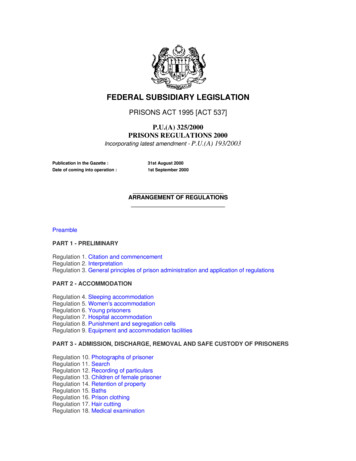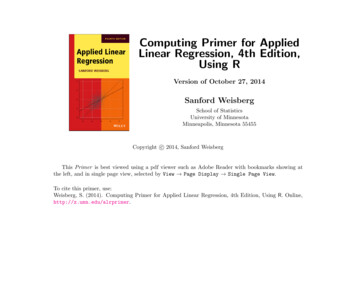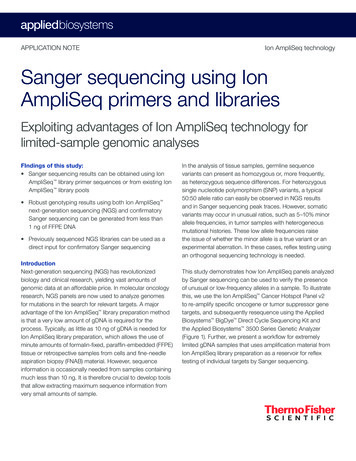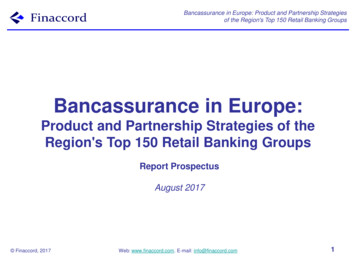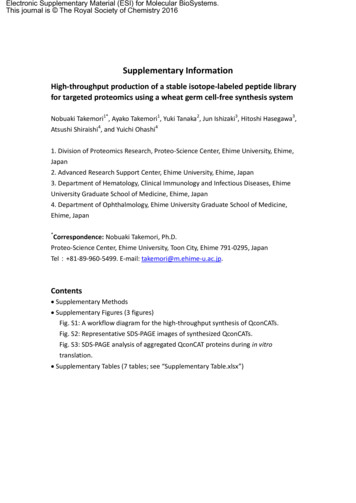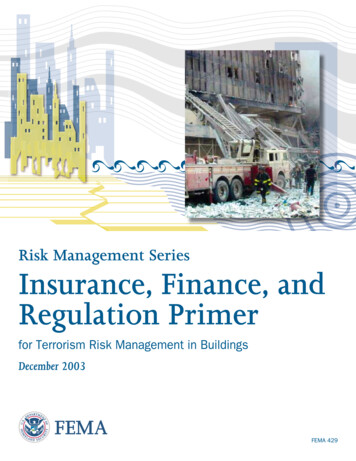
Transcription
FOREWORD AND ACKNOWLEDGEMENTSThis primer is a part of the Multihazard Risk Management Series of publicationsthat addresses terrorism risk in buildings. The objective of this primer is to introduce the building insurance, finance, and regulatory communities to the issue ofterrorism risk management in buildings and the tools currently available to manage that risk.ACKNOWLEDGEMENTSPrincipal Authors:Frederick Krimgold, Virginia TechDavid B. Hattis, Building Technology Inc.William I. Whiddon, Building Technology Inc.Contributors:Michael T. Chipley, UTD IncorporatedWesley W. Lyon, UTD IncorporatedMichael J. W. Kaminskas, UTD IncorporatedMark Hester, UTD IncorporatedProject Advisory Panel:Bernard M. Brown, Insurance Advisors, Inc.Mary Pat Denney, Freddie MacJoseph Donovan, Carr AmericaDottie Harris, New York State Department of StateLawrence H. Mirel, DC Department of Insurance and Securities RegulationMatt S. Munter, EMG CorporationTechnical Review:Deborah McKinnon, Mortgage Bankers AssociationDon Glitz, GMAC Commercial MortgageFEMA Advisory Panel:Christopher Arnold, Building Systems DevelopmentWade Belcher, General Services AdministrationCurt Betts, Army Corps of EngineersJim Caulder, U.S. Air Force – Civil Engineer Support AgencyJoseph Coughlin, FEMAMarcelle Habibion, Department of Veterans AffairsJoseph Hartman, Army Corps of EngineersEve Hinman, Hinman Consulting EngineersRick Jones, Naval Facilities Engineering Service CenterKurt Knight, Department of Veterans AffairsHoward Leikin, FEMAEric Letvin, URS CorporationJohn Lynch, Naval Facilities Command (NAVFAC) Criteria OfficeTerry Pruitt, Department of Homeland SecurityFOREWORD AND ACKNOWLEDGEMENTSi
Christopher Rojhan, Applied Technology CouncilLloyd Siegel, Department of Veterans AffairsProject Officer:Milagros Kennett, FEMA, Building Sciences Technology Branch,Mitigation DivisioniiFOREWORD AND ACKNOWLEDGEMENTS
CONTENTSCHAPTER 1Introduction . 1-1Intervening in the Building Investment Process . 1-2Primer Organization . 1-4Insurance . 1-4Finance . 1-5Regulation . 1-5Due Diligence for Terrorism Vulnerability Assessment . 1-6Guide to Expertise and Tools . 1-7CHAPTER 2Insurance and Terrorism Risk . 2-1Role of Insurance . 2-1Terrorism Risk for Insurers . 2-1Building Insurance Industry . 2-2Actuaries . 2-4Insurance Industry Infrastructure . 2-4Insurance Product Lines . 2-6World Trade Center Insurance Experience . 2-8Property and Liability . 2-8Business Interruption . 2-9Workers' Compensation, Health, and Life . 2-10Insurance Losses . 2-11Current Insurance Situation . 2-11Terrorism Risk Insurance Act of 2002 . 2-12Participation and Reimbursements . 2-13Limitations . 2-13Insurance Risk Management Models . 2-14Data Needs for Insurance . 2-15Lack of Actuarial Information . 2-16Future Developments . 2-16CHAPTER 3Finance and Terrorism Risk . 3-1Terrorism Risk Threat to Lenders . 3-1Building Finance Community . 3-1CONTENTSiii
Lenders Concerns . 3-2Terrorism Impact . 3-2Current Finance Situation . 3-4Lender Risk Management Models . 3-6Future Developments . 3-7CHAPTER 4Building Regulation and Terrorism Risk . 4-1Terrorism Risk for Regulators . 4-1Regulation of Terrorism Risk . 4-1Balancing Stakeholder Interests . 4-1Implications for Building Regulation Enforcement . 4-1Current Building Regulation Situation . 4-3Code Relation to Terrorist Threats . 4-3Regulatory Activities Related to Terrorism Risk . 4-4Building Regulation Management Models . 4-5Future Developments . 4-6CHAPTER 5Due Diligence: Estimating Vulnerability . 5-1Fundamental Changes . 5-1Due Diligence Assessment of Vulnerability to Terrorist Attack . 5-1Mitigation of Vulnerability . 5-2Process Model for Terrorism Risk Reduction Used inFederal Facilities . 5-2Protection Priority . 5-3Threat Assessment . 5-4Defining Threats . 5-5Identifying Likely Threat Event Profiles and Tactics . 5-6Assigning a Threat Rating . 5-10Alternative: Assigning a Level of Protection Against Threat . 5-11Vulnerability Assessment . 5-12Initial Vulnerability Estimate . 5-13Visual Inspection . 5-13Design Documents Review . 5-14Organization and Management Procedures Review . 5-14Assessment of Vulnerability to Expected Methodsand Means of Attack . 5-14Vulnerability Estimate Screening . 5-15ivCONTENTS
‘Site’ Questions . 5-16‘Architectural’ Questions . 5-17‘Structural and Building Envelope Systems’ Questions . 5-18‘Utility Systems’ Questions . 5-19‘Mechanical Systems’ Questions . 5-20‘Plumbing and Gas Systems’ Questions . 5-21‘Electrical Systems’ Questions . 5-22‘Fire Alarm Systems’ Questions . 5-23‘Communications and Information Technology Systems’Questions . 5-24Additional Sources of Detailed Facility Information . 5-25Vulnerability Reduction Cost Information and Estimates . 5-25CHAPTER 6Guide to Expertise and Tools . 6-1Terrorism Risk Insurance Act of 2002 . 6-1Building Vulnerability Assessment Screening . 6-1General Glossary . 6-2Chemical, Biological, and Radiological Glossary . 6-2Acronyms . 6-2Associations and Organizations . 6-2Bibliography . 6-3APPENDIX ATerrorism Risk Insurance Act of 2002 . A-1APPENDIX BBuilding Vulnerability Assessment Screening . B-1APPENDIX CGeneral Glossary . C-1APPENDIX DChemical, Biological, and Radiological Glossary. D-1APPENDIX EAcronyms . E-1APPENDIX FAssociations and Organizations . F-1APPENDIX GBibliography . G-1CONTENTSv
INTRODUCTION1This primer, FEMA 429, Insurance, Finance, and Regulation Primerfor Terrorism Risk Management in Buildings, is a part of theMultihazard Risk Management Series of publications that addresses terrorism risk in buildings. The objective of this primer isto introduce the building insurance, finance, and regulatorycommunities to the issue of terrorism risk management in buildings and the tools currently available to manage that risk.Insurance, finance and regulation are considered the 'change levers' of the built environment. They are the principalmechanisms for the evaluation and management of risk exposurein buildings. These change levers play a critical role in introducing and maintaining standards for risk management and publicsafety.CHANGE LEVERS FOR TERRORISM RISKREDUCTIONRisk management in the built environment is acomplex issue that involves a range of decisionmakers in all phases and at all levels in the buildingdevelopment, design, construction, and management process. The traditional market mechanismsfor estimating, pricing, and distributing risk are theinsurance and finance industries. The establishedmechanism for defining society's acceptable risklevels in the physical environment is the publicregulation of development, including zoning andbuilding regulation.Change Levers:InsuranceInsurance—those entities that will share some or all ofthe risks that a building owner faces.FinanceFinance—lenders (such as banks and corporateentities) and fiduciaries (such as pension funds andtrustees), which provide the resources for ownerinvestments in buildings.RegulationRegulation—governmental entities (federal, state, andlocal) that regulate building design, construction, anduse in order to achieve public health, safety, welfare,and other social objectives.Risks related to hazards such as fire, earthquake, flood, asbestos,and lead paint have been dealt with through these mechanisms.These risks have been identified and assessed, and applicable actuarial data has been collected. Physical measures for riskreduction have been developed and defined. Residual risks havebeen quantified and mechanisms for risk transfer are in place.The process of understanding and managing of terrorism risk isat its very beginning. All of the mechanisms of the traditionalINTRODUCTION1-1
TERRORISMThe term 'terrorism' refers to intentional, criminal,malicious acts. There is no single, universally accepteddefinition of terrorism. Officially, terrorism is defined inthe Code of Federal Regulations as " the unlawful useof force and violence against persons or property tointimidate or coerce a government, the civilianpopulation, or any segment thereof, in furtherance ofpolitical or social objectives" (28 CFR, Section 0.85). TheFederal Bureau of Investigation (FBI) furthercharacterizes terrorism as either domestic orinternational, depending on the origin, base andobjectives of the terrorist organization. However theorigin of the terrorist causing the threat is less relevantto terrorism risk management than the hazard itself andits consequences.The categories of terrorism threats are varied. Theprincipal threats that have been considered in theavailable literature include: Armed Attack Arson/Incendiary Attack Biological Agents Chemical Agents Conventional Bomb Cyber Terrorism Hazardous Material Release Nuclear Device Radiological Agents Surveillancebuilding risk management process must be engaged to address the issue of terrorism risk. Theymust understand the threat, develop the measuresfor risk reduction, and motivate the implementation of appropriate risk reduction measures. Thebuilding design and management communitiesmust develop the physical and operational solutions. But it is the change levers of finance,insurance, and regulation that can motivate andreward the implementation of those solutions.INTERVENING IN THE BUILDINGINVESTMENT PROCESSIt is necessary that guidance on the design, construction, and rehabilitation of buildings toreduce terrorism risk be made available to architects, engineers, and constructors. The otherpublications of the FEMA Multihazard Risk Management Series provide this guidance. However,architects, engineers, and constructors implementthe programs and directives of their clients—building developers and owners—who must beaware of the opportunity and the benefits of investing in terrorism risk reduction measuresbefore they decide to make such investments.Unauthorized EntryWhat motivates building owners to make investManagement of terrorism risk includes the assessmentment decisions about their buildings? Mostand consideration of this range of threats and theirowners view their buildings as revenue generators,varied delivery modes.not as instruments of social policy. Owners investin buildings in order to realize an economic return. How can owners be persuaded that investments to reducetheir vulnerability to terrorist attack will make business sense? Figure 1-1 is a schematic representation of the building processas it addresses the issue of terrorism risk reduction. Buildings arethe final product of this process. Designers and builders are keyactors in the implementation of physical mitigation of risk, but1-2INTRODUCTION
Figure 1-1: Terrorism Risk Reduction Decision-Makingbuilding owners and change levers are the key decision-makersregarding management of risk in buildings. In order to introduce physical or operational change in buildings (to reduceterrorism risk), it is necessary to intervene at several points.Builders who actually construct the buildings must be guided bythe plans and specifications developed by the design professionals (architects and engineers). The design professionals are, inturn, guided by the programs and demands of their clients, theowners. Building owners have functional, financial, and estheticobjectives that may or may not specifically include risk management. It is the change levers that are most sensitive to riskmanagement needs and are in a position to effectively leverageowner interests that are communicated to designers and builders.It is of key importance that owners demand appropriate mitigation measures in design, that designers have the specifictechnical guidance to provide required mitigation measures, andthat builders have the technical capability to implement appropriate designs. However, highest in this causative chain ofdecision-making are the change levers that influence the entireprocess that ultimately determines the end product.If investments cannot result directly in added profit in the formof increased rents or reduced operating costs, they will not beINTRODUCTION1-3
made, unless owners are induced or forced to make them by thechange levers. The change levers must create an environmentthat demands and rewards investment in safety.Regulators force such changes through laws that mandate terrorist resistant building design and construction. Lenders inducesuch changes by requiring them as conditions of the loan to acquire or construct the building, or by adjusting interest rates orother terms of the loan. Insurers can motivate such changes byrelating premiums to risk and rewarding effective mitigationIn order to introduce these changes, it is necessary for thechange levers to understand the character of terrorism risk, understand available risk reduction measures, and be able toevaluate related costs and benefits. This primer provides this information.PRIMER ORGANIZATIONInsuranceChapter 2 of this primer provides information on terrorism riskmanagement for the insurance industry.The insurance industry consists of three primary segments, eachof which has a unique role in the assessment of terrorism risk,and therefore can benefit from familiarity with the informationin this primer: Direct insurers Reinsurers Agents/brokersThe industry is supported by a complex infrastructure, each component of which will be able to use this information: Overseers/regulators Technical support Think tanks (risk modelers)1-4INTRODUCTION
Lobbying groups Independent advisors and consultantsThe industry also segments itself by product lines. Some of theselines have a direct relationship to building safety features, andothers may have an indirect relationship: Property, liability, and business interruption Workers' compensation Health (and health maintenance organizations) LifeBuyers of insurance are represented by various associations suchas the Risk and Insurance Management Society (RIMS), and theApartment and Office Building Association (AOBA).FinanceChapter 3 of this primer provides information that will be of useto both commercial and multifamily lenders, including: Loan originators Loan servicers Secondary markets Bond marketsRegulationChapter 4 provides information on terrorism risk managementfor the building regulatory community.There are four categories of building regulation that have thepotential to address terrorism risk reduction, and each has itsown array of audiences: Zoning and planning regulations Property maintenance codes Building rehabilitation codesINTRODUCTION1-5
FEDERAL RESOURCES FOR TERRORISMRISK MANAGEMENTTerrorism risk in the past has primarily been the concernof the Department of Defense and Federal intelligenceagencies. Before the attacks of September 11, 2001 thebulk of terrorism experience was outside the UnitedStates. The Federal Emergency Management Agency ofthe Department of Homeland Security is now providingbroad public access to available materials and methodspreviously developed for the assessment andmanagement of terrorism risk. Much of this material wasoriginally intended for "Official Use," but is now deemedto be of critical value for the management of terrorismrisk in the domestic civilian sector.The core reference document of the FEMA MultihazardRisk Management Series is FEMA 426, ReferenceManual to Mitigate Potential Terrorist Attacks AgainstBuildings. FEMA 426 includes reference to the terrorismrisk management and mitigation materials developedby: General Services Administration Naval Facilities Engineering Service Center Naval Facilities Command Criteria Office U.S. Army Corps of Engineers Protective Design Center Department of Veterans Affairs National Institute for Occupational Safety and Health Department of Justice, Office of DomesticPreparednessU.S. Air Force, Civil Support Agency Construction codes (building, mechanical,plumbing, electrical)All four categories of building regulation includeextensive reference to voluntary standards thatare developed by a wide array of organizations.These regulations are enforced by a variety of local and/or state agencies, each represented bytrade associations, including: Building officials and building departments Fire marshals and fire prevention bureaus Health departments Planning and community development departments and agenciesDue Diligence for TerrorismVulnerability AssessmentChapter 5 provides information on due diligencefor terrorism vulnerability assessment for individual buildings and facilities.Methods for threat assessment and vulnerabilityassessment are described and a framework for aqualitative terrorism risk 'vulnerability estimate' ispresented.Guide to Expertise and ToolsChapter 6 provides reference to resources, including: The Terrorism Risk Insurance Act of 2002 Building Vulnerability Assessment Screening A general glossary A chemical, biological, and radiological glossary A list of acronyms1-6INTRODUCTION
A list of associations and organizations related to terrorismrisk management A bibliographyINTRODUCTION1-7
INSURANCE AND TERRORISM RISK2ROLE OF INSURANCEInsurance plays a critical role in society in the management of risk. Insurance provides a mechanismfor spreading risk, which allows individuals to accept risks that would otherwise be unacceptable.Insurance also provides the service of pricing risk.On the basis of actuarial data and analysis insurersattempt to quantify risks and to set rates for the financing of risks.This chapter presents a discussion of terrorism risk. It isdirected at all segments and components of theinsurance industry so that they can begin to determinehow to establish an actuarial basis for insuring againstterrorism risk. The specific intent of this chapter is tohelp the insurance industry utilize its considerableinfluence on the building industry to encourageinvestments in terrorism risk mitigation.Property insurance has worked very well for a range of familiarhazards such as fire and windstorm. Not only has insuranceserved to transfer risks, it has also provided the database for identifying and reducing risks.Loss data has contributed to general understanding of perils andhas led to the development of effective mitigation measures. Recognition of the effectiveness of those mitigation or risk reductionmeasures has been reflected in differential premiums that provide a direct incentive for mitigation investment. Risk basedaccess to insurance and risk based pricing of insurance make it avery effective change lever strongly influencing building designand management practices.Terrorism Risk for InsurersTerrorism risk is new to the United States. The threat is not welldefined. There is very limited experience or actuarial data.There is even less experience of the effectiveness of protectivemeasures in buildings. The insurance industry is now strugglingto digest this new threat. Traditional means of analysis are so farineffective in providing the basis for pricing the risk.Lacking greater experience it is difficult to gauge the accuracy ofterrorism risk perception on the part of key participants in thereal estate industry. Potential buyers of terrorism risk coveragemust have a reasonable basis for estimating their insuranceneeds. At the same time, those selling insurance must have a defensible basis for pricing terrorism risk coverage. In the absenceof data or other means of determining premiums, and in light ofINSURANCE AND TERRORISM RISK2-1
the catastrophic loss potential of the risk, insurers left the market. In response to this crisis in the insurance market the federalgovernment has taken extraordinary measures to provide temporary support for the insurance market. These measures arediscussed later in this chapter.Insurance pricing and availability are also driven by market capacity and competition. Even without actuarially based rates thepricing mechanism of the market will come into play. Demandfor terrorism risk insurance is driven in part by building owners'perception of their risk and in part by the risk perception oftheir lenders. Both owners and lenders rely on the insurance industry to price such risks.Evaluation of terrorism vulnerability in planned and existingcommercial buildings can provide valuable input to the rating ofrelative risk for specific buildings. Criteria for the evaluation ofrelative terrorism risk in buildings can eventually contribute animportant component of the ratemaking equation. Recognitionby the insurance industry of effective risk reduction measuresshould provide guidance and incentive for investment in terrorism risk reduction.Some aspects of terrorism risk may be approached through community rating systems, such as that used in the National FloodInsurance Program, which reflect the target priority and the stateof security organization of a community. Because of the relationship of terrorism risk to national security policy it may provereasonable that the federal government role be extended.Building Insurance IndustryThe insurance industry consists of three primary segments, eachof which has a unique role in the assessment of terrorism risk,and therefore can benefit from familiarity with the informationin this primer: Direct insurers Reinsurers Agents/brokers2-2INSURANCE AND TERRORISM RISK
Direct insurers are the front line of the insurance industry. Thedirect insurer writes the policy, collects the premium and paysthe claim to the insured. Direct insurers are now required bystate insurance regulators to offer terrorism risk insurance. It isthe responsibility of the direct insurer to set premium rates basedon an analysis of exposure and risk. This rate structure must bereviewed and ultimately approved by the various state insurancecommissioners in most state jurisdictions.Ideally, direct insurers need basic information on the frequencyand severity of terrorist events and on the vulnerability of particular properties to terrorist attack in order to set specificpremiums. They must also know the effectiveness of specific mitigation measures in order to modify premium rates appropriately.Reinsurers provide insurance for direct insurers. That is, directinsurers are able to purchase reinsurance to cover some part oftheir exposure. Reinsurers are not regulated by state insurancecommissioners and are not required to provide reinsurance forterrorism risk. Following the World Trade Center (WTC) attackmost major reinsurers excluded terrorism risk from new treatieswith direct insurers. This created a temporary crisis in insurancemarkets in that direct insurers were required to provide terrorism risk insurance but they were no longer able to transfer partof that risk to reinsurers.Ideally, reinsurers need information on the frequency and severity of expected terrorist attacks on a global scale. They also needto be able to evaluate the effectiveness of the property risk assessment methodologies of their clients, the direct insurers.Insurance agents and brokers are the key connection between insurance buyers and sellers. Agents typically represent the sellerand brokers typically represent the buyers. Agents and brokerscommunicate directly with the policyholder or the buildingowner. It is necessary for agents and brokers to understand thespecific exposure and insurance needs of the client as well andthe policy conditions and exclusions of the insurer. In the case ofterrorism risk this will require understanding of the physical andINSURANCE AND TERRORISM RISK2-3
operational aspects of buildings that indicate vulnerability to terrorist attack.ActuariesActuaries are the foundation of the insurance business, and theyprovide services for each of the primary segments of the industry.The actuary assesses the available loss data to quantify the risk asthe basis for pricing risk and setting premiums. Actuarial dataand analysis is the basis for the pricing of risk and evaluating thesolvency of insurance companies. The key problem in the assessment of terrorism risk is the lack of actuarial data. There are veryfew examples of terrorist attack losses in the United States. It isvery difficult to generalize or project expected losses on the basisof this documented experience. Terrorism is not a well-definedor stable phenomenon. Without actuarial data it is difficult toprice the risk and it is difficult to defend proposed rates.Insurance Industry InfrastructureThe industry is supported by a complex infrastructure, each component of which will be able to use this information: Overseers/regulators (historically, insurance is regulated atstate level by insurance commissioners) Technical support: Insurance Services Office (ISO), NationalWorkers Compensation Commission, Association for Cooperative Operations Research and Development (ACORD),and others Think tanks (risk modelers) and risk control consultants:EQECAT, Risk Management Solutions (RMS), Applied Insurance Research (AIR), and others Lobbying groups: American Insurance Association (AIA), National Association of Insurance Brokers (NAIB), ReinsuranceAssociation of America (RAA), Risk and Insurance Management Society (RIMS), and othersState insurance commissioners have a primary responsibility toensure the solvency of insurance companies and their ability to2-4INSURANCE AND TERRORISM RISK
pay claims when required. This means they have a strong interestin the quality of actuarial data and analysis used in ra
Michael T. Chipley, UTD Incorporated Wesley W. Lyon, UTD Incorporated Michael J. W. Kaminskas, UTD Incorporated Mark Hester, UTD Incorporated Project Advisory Panel: Bernard M. Brown, Insurance Advisors, Inc. Mary Pat Denney, Freddie Mac Joseph Donovan, Carr America Dottie Harris, New York State Department of State
